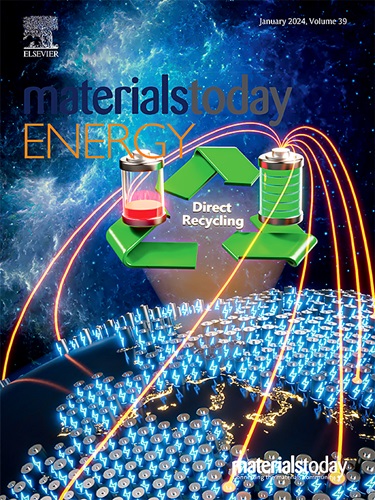通过操纵过氧化物形态减缓热载流子冷却动力学,实现高性能过氧化物太阳能电池
IF 8.6
2区 材料科学
Q1 CHEMISTRY, PHYSICAL
引用次数: 0
摘要
卤化铅包晶石的热载流子(HCs)冷却速度减慢,为实现高效包晶石太阳能电池(PSCs)带来了巨大希望。然而,有关包晶质量对 PSC 性能影响的研究还不够深入。在此,我们采用有机小分子三(五氟苯基)硼烷(TFB)作为添加材料,制备了高质量的过氧化物晶薄膜。研究发现,添加了 TFB 的包晶薄膜形貌更加平滑、无针孔,晶粒尺寸增大,阱态密度降低。更重要的是,超快瞬态吸收光谱结果表明,与原始包晶薄膜相比,掺杂了 TFB 的高质量包晶薄膜能显著减缓 HCs 的冷却过程,这有利于延长载流子的寿命并减少器件中的电荷载流子重组。因此,掺杂了 TFB 的基于 CsFAMA 的 PSCs 功率转换效率(PCE)从对照器件(20.22%)提高到了 22.56%。与对照器件 21.79% 的效率相比,用 TFB 处理的基于 FA 的 PSCs 的 PCE 高达 24.09%。此外,未封装的掺 TFB 器件在环境条件(湿度为 45%)下存储 1900 小时后,其初始值仍能保持 91%。这些发现为理解HCs的动力学以构建高效PSCs提供了一些启示。本文章由计算机程序翻译,如有差异,请以英文原文为准。
Slowing hot carriers cooling dynamics via perovskite morphology manipulating enable high-performance perovskite solar cells
Slowing hot carriers (HCs) cooling of lead halide perovskites exhibits great promise for achieving highly efficient perovskite solar cells (PSCs). However, the effect of the quality of perovskite on PSCs performance has not been well studied. Herein, we fabricated high-quality perovskite films by employing an organic small molecule, tris(pentafluorophenyl)borane (TFB) as an additive material. It was found that the perovskite films with TFB become smoother and pinhole-free morphology with increased grain size and reduced trap-state density. More importantly, ultrafast transient absorption spectroscopy results reveal that the high-quality TFB-doped perovskite films can significantly slow down HCs cooling process compared with pristine perovskite film, which is beneficial for prolonging the lifetime of carriers and reducing the charge carrier recombination in the device. Accordingly, the power conversion efficiency (PCE) of CsFAMA-based PSCs doping with TFB is enhanced to 22.56% from the control device (20.22%). Compared with 21.79% efficiency for the control device, a high PCE of 24.09% is obtained in FA-based PSCs treated with TFB. Besides, the unencapsulated TFB-doped device retains 91% of its initial value after storing for 1900 h under ambient conditions (∼45% humidity). These findings provide some insights for understanding HCs’ dynamics for constructing highly efficient PSCs.
求助全文
通过发布文献求助,成功后即可免费获取论文全文。
去求助
来源期刊

Materials Today Energy
Materials Science-Materials Science (miscellaneous)
CiteScore
15.10
自引率
7.50%
发文量
291
审稿时长
15 days
期刊介绍:
Materials Today Energy is a multi-disciplinary, rapid-publication journal focused on all aspects of materials for energy.
Materials Today Energy provides a forum for the discussion of high quality research that is helping define the inclusive, growing field of energy materials.
Part of the Materials Today family, Materials Today Energy offers authors rigorous peer review, rapid decisions, and high visibility. The editors welcome comprehensive articles, short communications and reviews on both theoretical and experimental work in relation to energy harvesting, conversion, storage and distribution, on topics including but not limited to:
-Solar energy conversion
-Hydrogen generation
-Photocatalysis
-Thermoelectric materials and devices
-Materials for nuclear energy applications
-Materials for Energy Storage
-Environment protection
-Sustainable and green materials
 求助内容:
求助内容: 应助结果提醒方式:
应助结果提醒方式:


